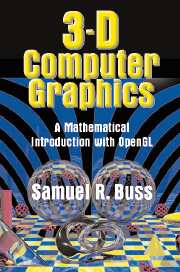Book contents
- Frontmatter
- Contents
- Preface
- I Introduction
- II Transformations and Viewing
- III Lighting, Illumination, and Shading
- IV Averaging and Interpolation
- V Texture Mapping
- VI Color
- VII Bézier Curves
- VIII B-Splines
- IX Ray Tracing
- X Intersection Testing
- XI Radiosity
- XII Animation and Kinematics
- A Mathematics Background
- B RayTrace Software Package
- Bibliography
- Index
- Plate section
B - RayTrace Software Package
Published online by Cambridge University Press: 05 June 2012
- Frontmatter
- Contents
- Preface
- I Introduction
- II Transformations and Viewing
- III Lighting, Illumination, and Shading
- IV Averaging and Interpolation
- V Texture Mapping
- VI Color
- VII Bézier Curves
- VIII B-Splines
- IX Ray Tracing
- X Intersection Testing
- XI Radiosity
- XII Animation and Kinematics
- A Mathematics Background
- B RayTrace Software Package
- Bibliography
- Index
- Plate section
Summary
Introduction to the Ray Tracing Package
I have written a ray tracing package that implements basic recursive ray tracing. This software and its source code are freely available and can be downloaded from this book's Web site.
The ray tracing software uses an object-oriented approach to rendering and ray tracing. The object-oriented design includes base classes for materials, for geometric shapes, for lights, and for textures. This provides considerable flexibility in adding features since it allows the addition of new geometric shapes without affecting the functionality of older code; similarly, new kinds of lighting models, new kinds of textures, and so on, can be added without needing to change the structure of the software.
The material and lighting classes supported by the software include the usual material properties such as ambient, diffuse, and specular color and specular exponents. In addition, the material classes include reflection and transmission color coefficients for use in recursive ray tracing. The complete Phong model for local lighting is supported, including all the OpenGL-type features such as spotlights and attenuation. A version of the Cook–Torrance model is also supported.
The ray tracing software supports a range of geometric shapes, including spheres, triangles, parallelograms, cones, cylinders, tori, ellipsoids, parallelepipeds, and Bézier patches. Collectively, these geometric shapes are called viewable objects. The viewable object classes are responsible for detecting intersections of rays against a particular geometric shape. The viewable object classes also calculate normals and keep track of the material of an object.
- Type
- Chapter
- Information
- 3D Computer GraphicsA Mathematical Introduction with OpenGL, pp. 332 - 352Publisher: Cambridge University PressPrint publication year: 2003



